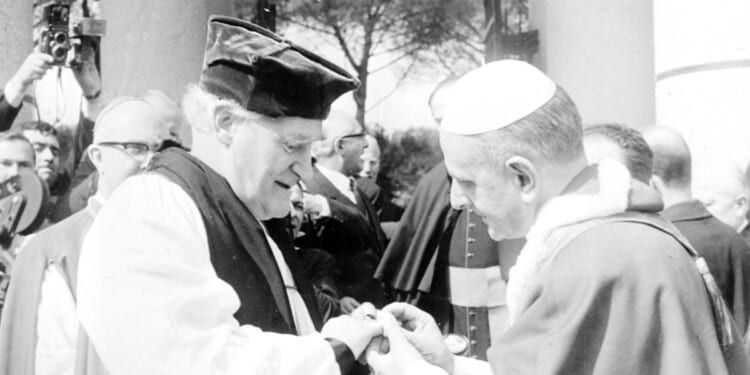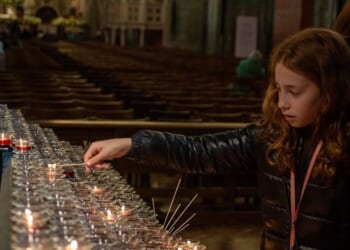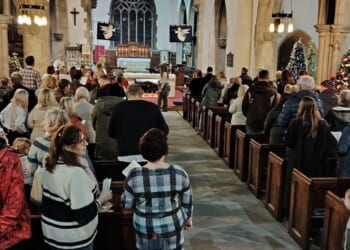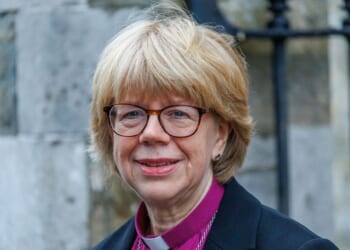THE recent state visit of the King to the Vatican (News, 31 October) was a remarkable affirmation of the closer relations that have grown between the Anglican and Roman Catholic Churches during the past 60 years. For the press, with its fondness for simplistic headlines, it was a “first”: the first time that a British monarch and a Pope had prayed together — as they did in the Sistine Chapel — since the Reformation. But it was actually the culmination of a process of rapprochement which began with the Second Vatican Council.
It was the announcement of the Council by Pope John XXIII, in 1959, which prompted the visit of Archbishop Geoffrey Fisher to the Vatican the following year. It was the Council that precipitated the creation of the Anglican Centre in Rome, a permanent base for the Anglican Communion in Rome to enable close contact with the Vatican (and which celebrates its 60th anniversary next year). And it was the Council that, in its transformation of the RC Church’s ecumenical outlook, made possible Archbishop Michael Ramsey’s visit to Rome in 1966, at which the official Anglican-Roman Catholic theological dialogue was announced. Since Pope Paul VI slipped his episcopal ring on to Michael Ramsey’s finger — to Ramsey’s astonishment — many further visits and encounters have encouraged this warming up of relations.
Within the RC Church, there is a lively debate over whether the Council was a change mainly of tone, or of substance as well as tone. In its decree on ecumenism, Unitatis redintegratio (“The restoration of unity”), the Council made what can only be seen, in context, as a radical departure from the RC Church’s long-settled position.
Gone was the assumption that the only viable basis of church unity was simple conformity to the RC Church’s norms, doctrine, and discipline. Now the real but imperfect communion that Catholics shared with other Churches was affirmed, the baptised of all Christian traditions were acknowledged as incorporated into Christ, and dialogue and mutual learning were the ways by which the goal of Christian unity should be pursued.
What followed was the inauguration of the official theological dialogue between our churches. The Anglican-Roman Catholic International Commission (ARCIC) first met in 1970, after considerable preparatory work. ARCIC I, as it became known, submitted its Final Report in 1981.
The baton was then taken up by a second incarnation, ARCIC II, which, in turn, completed its work in 2005. A third cycle, ARCIC III, is close to completing its work on communion and ethics. If we include the forthcoming ARCIC III text on ethics, some 15 documents of varying length and complexity constitute a formidable library of statements of agreement or convergence on a wide range of Christian doctrine and church order.
WHAT has been achieved by more than 50 years of dialogue? The range of agreement noted by ARCIC is astonishing, considering the contrast with the time before, when Catholics conventionally regarded Anglicans, like other Protestants, as heretics. Positions on the eucharist, ordination, and ministry which lay behind the condemnation of Anglican orders in 1896 have been severely modified, if not abandoned altogether.
Agreement is, if anything, even more substantial and noteworthy the further one goes into the Trinitarian and Christological heart of our faith. We really are, in belief, two Christian communities who are journeying together towards that distant goal of full visible unity.
Of course, significant disagreements remain, and some have widened over the same period. Our church cultures differ markedly in some respects. Both Churches use different language and have their own internal differentiation.
Anglicans have a formidably diverse internal economy, so much so that Roman Catholics are sometimes confused about what particular group really represents the Anglican position. And they have their own internal divisions, too, which are obscured by a more centralised polity and by a strong sense of the magisterium — the agreed teaching — of the whole Church.
Even as many differences have been resolved or diluted, others have come between us, including the ordination of women and the acceptance of same-sex relations by some Anglican Churches. Even so, so close is our agreement on fundamental matters that the question how we can give greater effect to the unity and communion that we already share is more pressing than ever.
Yet, while doctrinal agreement is vital, Christian unity will not be built on theological dialogue alone. During the past 60 years, there has been an equally remarkable rapprochement in local, regional, and national institutional links of various kinds.
Roman Catholics and Anglicans join together in many local church partnerships, and in social and charitable work. In England, joint meetings of RC and Anglican bishops happen routinely every other year. Internationally, through the International Anglican-Roman Catholic Commission for Unity and Mission (a mouthful — the acronym IARCCUM really is easier), pairs of RC and Anglican bishops have been on pilgrimage together, and built close friendships across the world.
THE heart of Christian life is relationship; and so the heart of the Christian journey towards the goal of the full visible unity of the Church is building and sustaining warm, compassionate, and mutually appreciative relationships between people of different traditions.
In this, the warmth of friendship between recent popes and Archbishops of Canterbury — especially Archbishop Rowan Williams and Benedict XVI, and Archbishop Welby and Francis — has been an important symbol. So, too, was the recent royal visit, a sign of how deep and how far the post-Vatican II thawing has gone. It is vital that this momentum, with its warmth of friendship between church leaders, is maintained in years to come, and not allowed to decline.
The chair given to the King by the Abbey of St Paul’s-outside-the-Walls last month carries the inscription Ut unum sint. Jesus prays in John 17 that all his followers may be one. A prayer of Jesus is surely a command for his followers. No one can really believe that the unity of the Church is just around the corner: it is, no doubt, a distant horizon. But it is a necessary challenge, too. So much has changed between the RC and Anglican Churches in the past 60 years. Those who long to fulfil Jesus’s prayer must hope that the next 60 years will also be a time of dramatic change.
Canon Jeremy Morris, a former national C of E adviser on ecumenical relations, is a church historian.

















